 W
WThe Ancient Order of St. George, also known as the Order of the Four Roman Emperors or Order of the Ancient Nobility, is a historic secular order of chivalry.
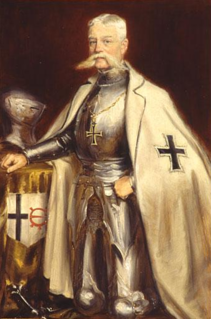 W
WThe Bailiwick of Utrecht of the Teutonic Order is a charity based in Utrecht, Netherlands. It originated in 1231 as a division of the order of Teutonic Knights. During the Protestant Reformation most of the members became Protestant, mainly Reformed or Lutheran. The Bailiwick cut its ties with the order based in the Holy Roman Empire and placed itself under the protection of the United Provinces of the Netherlands. The order was briefly suppressed during the Napoleonic era, but revived in 1815 after the restoration of the House of Orange. In 1995 it returned to the Duitse Huis as its headquarters, a building that dates from 1348.
 W
WThe Order of the Band, Knights of the Band, or Equites Bindae, were a military order in Spain, instituted by Alfonso XI, King of Castile in 1332. It takes its name from the banda, band, sash or red ribbon which came across over the right shoulder and under the left arm of the knight.
 W
WThe Order of the Crown of Italy, Italian: Ordine della Corona d'Italia, was founded as a national order in 1868 by King Vittorio Emanuele II, to commemorate the unification of Italy in 1861. It was awarded in five degrees for civilian and military merit.
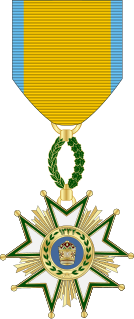 W
WThe Order of the Crown was founded in 1913 by Shah Ahmad Shah Qajar before his coronation as the highest dynastical and state order. Until 1926 it existed in two classes. The 1st class had a collar reserved for the Shahanshah and the Crown-Prince. The Order was preserved in Iran after the fall of Qajars. Until the reform of the Order in 1938/39 the sash was blue with thin green-white borders, but after the reform was corn-yellow with sky-blue edges.
 W
WThe Order of Prince Danilo I was an order of the Principality and later Kingdom, of Montenegro. It is currently a dynastic order granted by the head of the House of Petrović-Njegoš, Crown Prince Nicholas. It is awarded to prominent champions of the preservation of Montenegrin independence and for other humanitarian, scientific, artistic and pro-social achievements as defined by statute.
 W
WThe Order of the Dragon was a monarchical chivalric order only for selected higher aristocracy and monarchs, founded in 1408 by Sigismund of Luxembourg, who was then King of Hungary and later became Holy Roman Emperor. It was fashioned after the military orders of the Crusades, requiring its initiates to defend the cross and fight the enemies of Christianity, particularly the Ottoman Empire.
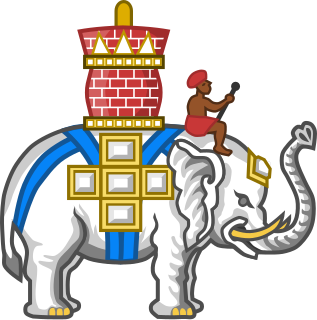 W
WThe Order of the Elephant is a Danish order of chivalry and is Denmark's highest-ranked honour. It has origins in the 15th century, but has officially existed since 1693, and since the establishment of constitutional monarchy in 1849, is now almost exclusively used to honour royalty and heads of state.
 W
WThe Imperial and Royal Decoration of Elizabeth and Theresa was a decoration of the Austro-Hungarian Empire, created in 1750 by Empress Consort Elizabeth Christine in her testament. It was later revised in 1771 by her daughter Empress Maria Theresa I, Holy Roman Empress, as the Elizabetho-Theresian Military Foundation.
 W
WThe Order of the Holy Spirit, is a French order of chivalry founded by Henry III of France in 1578. Today, it is a dynastic order under the House of France.
 W
WL'Ordre de l'Harmonie, also called Solfjädersorden, was a Swedish royal dynastic order, founded by Queen Louisa Ulrika of Sweden in 1744. It was awarded to 22 people between 1744 and 1746.
 W
WThe Supreme Order of the Most Holy Annunciation is a Roman Catholic order of knighthood, originating in Savoy. It eventually was the pinnacle of the honours system in the Kingdom of Italy, which ceased to be a national order when the kingdom became a republic in 1946. Today, the order continues as a dynastic order under the jurisdiction of the Head of the House of Savoy.
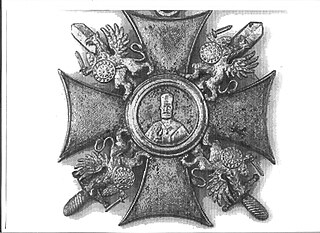 W
WThe Imperial War Order of Saint Nicholas the Wonderworker was originally a medal, instituted in 1929 by the Russian pretender, Grand Duke Cyril Vladimirovich and conferred on Russian veterans who had fought in the First World War. A similar order was established by General Wrangel as Order of Saint Nicholas Thaumaturgus.
 W
WThe Royal Military and Hospitaller Order of Our Lady of Mount Carmel and Saint Lazarus of Jerusalem united was a chivalric order instituted in 1608 by personal union of the medieval Order of Saint Lazarus in France and the new Order of Our Lady of Mount Carmel of King Henry IV of France. The union of the two orders was recognised by a bull of Cardinal Louis de Bourbon, papal legate in France, dated 5 June 1668.
 W
WThe Order of Mathilde (Mathildeordenen) was a Danish royal order, created by the queen of Denmark, Caroline Matilda of Great Britain, after which it was named, on the birthday of the king, Christian VII of Denmark, 29 January 1771. It was no longer used after the banishment of its founder the year after.
 W
WThe Order of Prohibited Legitimacy, known as La Orden de la Legitimidad Proscrita in Spanish, is a Spanish dynastic order of knighthood originally awarded by the House of Bourbon and later by a cadet branch, the House of Bourbon-Parma, to Carlist supporters. The order was founded in 1923 by Prince Jaime, Duke of Madrid, a Carlist claimant to the Spanish throne and a Legitimist claimant to the French throne, for rewarding loyalists of the Carlist movement. In modern times, there are two branches of the Order. One branch's Grand Master is Prince Carlos, Duke of Parma while the other's is his uncle, Prince Sixtus Henry, Duke of Aranjuez.
 W
WThe Order of Saint Joachim is an order of chivalry founded in 1755 to promote religious tolerance in Europe, and continues to exist today. Admiral Horatio Nelson accepted the Grand Cross of the Order in 1802.
 W
WThe Order of St. George – A European order of the House of Habsburg-Lorraine, or simply Order of Saint George, is a dynastic order of chivalry and thus a house order of the House of Habsburg, the former Imperial and Royal House of the Holy Roman Empire, the Habsburg Monarchy, the Empire of Austria, the Austro-Hungarian Monarchy, the Kingdom of Hungary, the Crown lands of Bohemia and Croatia and further nations.
 W
WThe Imperial Order of the Double Dragon was an order awarded in the late Qing dynasty.
 W
WThe Order of the Eagle of Georgia and the Seamless Tunic of Our Lord Jesus Christ commonly known as the Order of the Eagle of Georgia (OEG), is the highest order of chivalry awarded by the House of Bagration, whose Chief and Grand Master is Prince David Bagration of Mukhrani. Prince David became the disputed head of the Royal House and the order when his father, Prince Jorge de Bagration, died.
 W
WThe Order of the Rue Crown or Order of the Crown of Saxony was a dynastic order of knighthood of the Kingdom of Saxony. The order takes its name from the green floral crown of rue (crancelin) found in the coat of arms of Saxony. It occupies the highest rank of the former Saxon honour system.
 W
WThe Order of Saint Peter of Cetinje is the a dynastic order of the Royal House of Petrović-Njegoš. As Montenegro is now a republic, the order is distributed as a private house order of the deposed family. The Order is bestowed upon prominent members of the Petrović-Njegoš family, as well as to others.
 W
WThe Order of the Queen of Sheba was originally instituted as a ladies' order in 1922 in the Ethiopian Empire by Empress Zawditu.
 W
WThe Royal and Hashemite Order of the Pearl is the dynastic order of the Royal House of Sulu, which serves as the premier institution and the highest personal honour of and in the Royal Sultanate of Sulu. The order is an honourable and nobiliary corporation instituted as a dynastic Order of Datuship analogous to traditional dynastic orders of chivalry, and is in direct continuation from the ancient customs and distinctions of the Royal Sultanate of Sulu and the Court of the Sultan. Ampun Sultan Muedzul Lail Tan Kiram, as Head of the Royal House of Sulu, is the hereditary sovereign who processes the fons honorum and Grand Sayyid of the order, and his heirs and successors as heads of the Royal House of Sulu, shall ever be sovereigns and Grand Sayyids of the order.
 W
WThe Royal Order of the Seraphim is a Swedish order of chivalry created by King Frederick I on 23 February 1748, together with the Order of the Sword and the Order of the Polar Star. The order has only one class with the dignity of Knight, and is the foremost order of Sweden.
 W
WThe Order of the Seal of Solomon is an order of knighthood of the Ethiopian Empire, founded by Emperor Yohannes IV in 1874 as the highest imperial honour, containing five grades. In 1930, an even higher Order was established, i.e. the Order of Solomon, which was a split off from the Order of the Seal of Solomon. The Order was conferred on members of imperial house and upon persons who had rendered meritorious services.
 W
WThe Order of Saint Stephen is a Roman Catholic Tuscan dynastic military order founded in 1561. The order was created by Cosimo I de' Medici, first Grand Duke of Tuscany. The last member of the Medici dynasty to be a leader of the order was Gian Gastone de Medici in 1737. The order was permanently abolished in 1859 by the annexation of Tuscany to the Kingdom of Sardinia. The former Kingdom of Italy and the current Italian Republic also did not recognize the order as a legal entity but tolerates it as a private body.
 W
WThe Imperial Commemorative Medal “In Memory of the 100th Anniversary of the Great War, 1914-1918”, is a dynastic award instituted in 2015 by Grand Duchess Maria Vladimirovna of Russia, Head of the former Russian Imperial House.
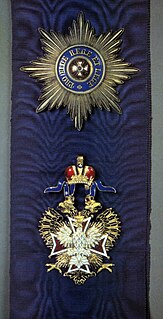 W
WThe Order of the White Eagle was an Imperial Russian Order based on the Polish honor. Emperor Nicholas I of Russia established the award in 1831 as the Imperial and Royal Order of the White Eagle. A recipient of the Order was granted the title Knight of the Order of the White Eagle.